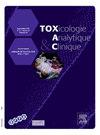Optimization and validation of a Dried Blood Spot (DBS) method for high-resolution mass spectrometry in forensic toxicology
IF 1.8
Q4 TOXICOLOGY
引用次数: 0
Abstract
Aim
This study aimed to optimize, validate, and apply a toxicological screening method using Dried Blood Spot (DBS) coupled with high-resolution mass spectrometry (HRMS) in forensic toxicology. The primary goals included method refinement for extraction and analysis, validation based on critical performance parameters, and testing the method with post-mortem blood samples.
Method
Samples containing 20 xenobiotics from diverse pharmacological classes were prepared for DBS analysis. Targeted and non-targeted toxicological screening was performed by LC-HRMS (Orbitrap Exploris 120, ThermoFisher Scientific). Optimization included the extraction process (sonication time, recovery volume) and analytical parameters (injection volume, ion intensity thresholds for data dependent analysis). Validation followed European Medicines Agency (EMA) guidelines, assessing repeatability, reproducibility, stability, linearity, matrix effect, extraction yield, and lower limits of quantification (LLOQ). The limit of identification (LOI) was also evaluated with 135 compounds. Post-mortem blood samples (n = 20) were analyzed to compare the method's accuracy and sensitivity with the laboratory's standard LC-HRMS procedure.
Results
Optimization yielded a final DBS method with a recovery volume of 70 μL, 30-minute sonication, and a 25 μL injection volume. Validation demonstrated reproducibility, linearity, and acceptable LLOQ for most compounds, while some issues arose with stability at room temperature (mephedrone and 6-acetylmorphine) and matrix effect (ketamine). Extraction yields were low overall (15–85%), but sensitivity was sufficient for the detection of therapeutic concentrations (mean LOI of 48 ng/mL for 135 compounds). Comparative analysis with LC–HRMS showed similar identification results (65 compounds), except for three discrepancies (bisoprolol (6 ng/mL), codeine (< 5 ng/mL) and oxazepam (5 ng/mL) were not detected using DBS) confirming the DBS method's detection capability.
Conclusion
The DBS method effectively balances small sample volumes and analytical robustness, presenting a reproducible, linear, and sensitive alternative for toxicological screenings. While unsuitable for precise quantification in forensic settings, DBS offers potential for qualitative analyses and broader toxicological applications. Further validations, including inter-sample contamination and extended compound library integration, should be done to make this method suitable for routine analysis of post-mortem blood samples.
用于法医毒理学高分辨率质谱分析的干血斑(DBS)方法的优化与验证
目的优化、验证干血斑(DBS) -高分辨率质谱(HRMS)联用在法医毒理学筛选中的应用。主要目标包括提取和分析方法的改进,基于关键性能参数的验证,以及用死后血液样本测试方法。方法制备20种不同药理学类别的外源药物样本进行DBS分析。采用LC-HRMS (Orbitrap Exploris 120, ThermoFisher Scientific)进行靶向和非靶向毒理学筛选。优化包括提取工艺(超声时间、回收率)和分析参数(进样量、数据依赖分析的离子强度阈值)。验证遵循欧洲药品管理局(EMA)指南,评估重复性、再现性、稳定性、线性、基质效应、提取率和定量下限(LLOQ)。并对135个化合物进行了鉴定限(LOI)评价。对20份尸检血液样本进行分析,以比较该方法与实验室标准LC-HRMS程序的准确性和灵敏度。结果优化后的DBS方法回收率为70 μL,超声时间为30 min,进样量为25 μL。验证表明大多数化合物的重现性、线性和可接受的定量限,但在室温下的稳定性(甲氧麻黄酮和6-乙酰吗啡)和基质效应(氯胺酮)存在一些问题。提取率总体上较低(15-85%),但灵敏度足以检测治疗浓度(135种化合物的平均LOI为48 ng/mL)。与LC-HRMS的对比分析显示,除了3个差异(比索洛尔(6ng /mL)、可待因(<;5ng /mL)和恶西泮(5ng /mL)未被DBS检测到,证实了DBS方法的检测能力。结论DBS方法有效地平衡了小样本量和分析稳健性,为毒理学筛选提供了可重复性、线性和灵敏度高的替代方法。虽然不适用于法医环境中的精确定量,但DBS为定性分析和更广泛的毒理学应用提供了潜力。进一步的验证,包括样品间污染和扩展的化合物文库整合,应使该方法适用于尸检血液样本的常规分析。
本文章由计算机程序翻译,如有差异,请以英文原文为准。
求助全文
约1分钟内获得全文
求助全文

 求助内容:
求助内容: 应助结果提醒方式:
应助结果提醒方式:


